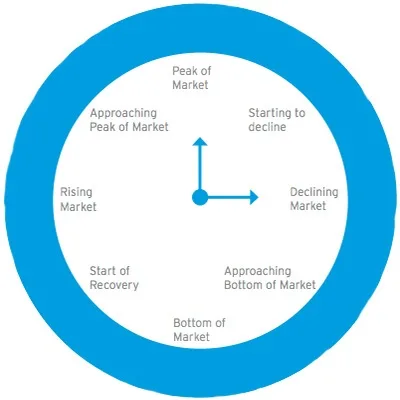Whether you’re a first home buyer or an experienced property investor, you’ll probably be aware of the importance of buying or selling at just the right time. Most of us aren't trying to "time" the market, but are instead playing a longer-term game that starts with a fundamental understanding of the property cycle.
Property markets in Australia and around through the world go through a cycle, and if you manage to time your purchase or sale just right it can make a difference of tens of thousands of dollars. You can use a concept called the property clock to visually understand the property cycle.
Understanding the property cycle
The property cycle is a series of events that repeat themselves over and over in a cyclical pattern that impacts on property prices. This cycle can be broken down into four different phases: boom, downturn, stabilisation and upturn.
As our population grows the demand for real estate is increased, which causes an increase in property values. This demand is met with keen builders and developers constructing new dwellings to meet demand.
This demand may then peak, as an oversupply of properties can lead to a slump in valuations.
Thankfully, being a cycle for every downturn there is a new upswing towards another boom. Luckily property slumps in Australia have been reasonably temporary, with strong growth in our capital cities through 2021 expected to last into 2022.
What is the property clock and how does it work?
Investors can track the property market cycle using the property clock<, which is made up of eight steps that fall within the four property cycle phases.
The property clock is a useful method of tracking the property market cycle. It is based on the recognised stages of the property cycle: a “boom” followed by a downswing in prices, “bust” as the market hits the bottom of the cycle, and then a recovery period as the market builds towards the next boom.
 This clearly-defined cycle can be expressed in the form of a clock. When the hour hand on the clock is at 12, the property market is in a boom period, demand is outpacing supply and prices are at their peak. As the hand moves down clockwise around the face, the market enters a downswing period and prices start to cool until, when the hand reaches 6, there is an oversupply of houses and the market bottoms out.
This clearly-defined cycle can be expressed in the form of a clock. When the hour hand on the clock is at 12, the property market is in a boom period, demand is outpacing supply and prices are at their peak. As the hand moves down clockwise around the face, the market enters a downswing period and prices start to cool until, when the hand reaches 6, there is an oversupply of houses and the market bottoms out.
But then things start to turn around as the recovery period begins. Rental returns start to improve and interest rates fall, which means demand for housing increases and prices start to rise once again. This continues as the hand moves further around the clock face and up towards 12, the next boom period once again.
How do you identify a city or suburb's position in a property cycle?
Although Australia is spoken about generally when discussing the property market, each state and even suburb can be sitting at a different stage of its own property cycle.
There are many factors to look at when trying to identify where a city is sitting in a property cycle. The local economy, demographics, planned infrastructure and developments can all be key indicators of a suburb on the rise or about to bottom out.
Start with an online search. Most government websites provide community profiles that will detail information about future council plans or building regulations.
You can also access free suburb reports through the website Residex, which lets you enter your suburb, postcode and state to generate a PDF report in mere minutes.
Next look at the economic factors impacting prices. Look for areas with steady employment growth and finance pre-approval trends.
How useful is the property cycle as a concept?
The property cycle is handy as a tool to analyse the current market. It is not a predictor of future performance and should be used in conjunction with other sound research and expert advice.
Knowing the best time to buy within the property cycle also isn't much good if you buy a dud property. Although a useful consideration when searching for your next investment property, the property cycle is not always significant for most long-term investors' strategies.
How else can I research the property market?
Aside from using the property clock there are plenty of ways to dig deeper into the property market. This might be:
- Asking local real estate agents, mortgage brokers or property developers about an area
- Checking the local council website for any upcoming developments like transport, business networking or scheduled improvements to public facilities
- Checking the census for detailed demographic information on a particular postcode
We've also covered off the other ways to research the property market here.
Pictures: Herron Todd White, Shutterstock.
Ask a question
More guides on Finder
-
How to invest in property using a line of credit or home equity loan
If you're looking to invest in property, a line of credit loan could be a great way to leverage the equity in your existing property for a deposit. A home equity loan is a loan in which you put your property up as security to borrow against the equity of your home.
-
What is rental yield?
What is a rental yield? Learn what property investors need to know about calculating rental returns.
-
Should I pay off my mortgage or invest?
If you've got the cash flow and you've paid your mortgage down, investing in property can be a wise move.
-
Capital gains tax on property
When you sell a rental investment property and make a profit, you will generally need to pay Capital Gains Tax. Some exemptions and discounts apply: here's how to work out how much CGT could cost you.
-
Investment loans versus owner-occupier home loans
Learn about the key differences between investment and owner-occupier home loans and find the right type for your needs.
-
Buying an apartment checklist
A guide to buying a unit as a property investment, plus a helpful downloadable checklist.
-
Should you invest in a serviced apartment?
Should you invest in a Mantra, Quest or other brand of serviced apartment? We answer all your questions from rent to home loans in our guide.
-
How investors can use an interest-only loan with an offset account
Investors often pair an interest only home loan with an offset account to maximise tax savings. Here's what you need to know about it.
-
How to research the real estate market in 7 steps
Follow these clear steps on how to research the property market to get the best deal or make a good investment.
-
Can I afford an investment property?
Buying an investment property been on your wish list for a while? If you’re wondering ‘how much do i need to buy an investment property’ our guide has the answers.
